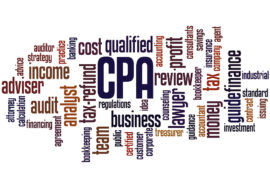
Understanding Financial Statements: A Guide for New Business Owners
Most new business owners who approach me about being clients understand how important it is that they pay their taxes. But what many of them don’t understand is that, if you want your taxes to be correct, you have to have accurate financial statements!
What Are Financial Statements?
Financial statements are formal records that provide a comprehensive overview of a company’s financial activities and position. These documents offer essential insights into a company’s financial health and performance, and are helpful tools for a company’s financial management.
Why Are They Important?
At Wood CPA, we require all our business clients to let us do their bookkeeping. We used to encounter business owners who insisted we didn’t need to worry about their financial statements because they “just use QuickBooks” or “didn’t have many transactions.”
But here’s the truth: When it comes to business bookkeeping, relying on Quickbooks isn’t going to cut it. Why? Because software can’t catch or fix user error, and if your numbers aren’t right, the taxes you pay at the end of the year won’t be correct, either.
This can cause big problems down the line — and a huge headache for your CPA come tax time! Here’s a sticker I recently stumbled upon that I think sums up the feelings of CPAs everywhere.
And having accurate financial statements for small businesses isn’t just about keeping your CPA and the IRS happy (although that’s certainly part of it). Accurate financial statements are the foundation of your business’s health and growth. They help you:
- Assess the health of your business
- Make informed management decisions (Like when to hire or adjust pricing)
- Apply for loans when you need them
- Determine if you’re actually profitable (Money in the bank doesn’t always equal profit!)
The bottom line is, if you want to be able to assess the health of your business, pay your taxes, and know when to grow, you need to make sure your financial statements are accurate. And a CPA has the training and expertise to do just that.
3 Key Financial Statements: P&L, Balance Sheet, & Cash Flow
In this guide, we’ll break down the three key financial statements every business owner should know: the Profit & Loss Statement, the Balance Sheet, and the Cash Flow Statement. We’ll explain what they are, why they matter, and how they can help you make smarter decisions for your business.
1. The Profit and Loss Statement
The Profit and Loss Statement (P&L), also known as the Income Statement, shows your business’s profitability over a specific time period. This statement is primarily used for determining what you’ll pay in taxes.
Your profitability is found by using a simple equation:
Income – Expenses = Profit (or Loss)
But for many new business owners who are just starting out, this can be where it gets tricky. Some people aren’t sure what qualifies as income or what qualifies as an expense. Let’s break it down.
Income:
Income includes:
- Product sales
- Services provided
- Interest earned on bank accounts
- Other money earned (rebates, referral fees, commissions)
Income does NOT include:
- Loan proceeds
- Funds put into the business by the owner or investors
- Transfers between accounts
- Sales tax collected from customers
Expenses:
The IRS defines a business expense as “reasonable and necessary” to operate the business. This includes:
- Cost of goods sold
- Rent, supplies, advertising, marketing
- Bank/merchant fees, professional fees
- Insurance, dues & subscriptions
- Wages
- Interest, depreciation, amortization
What’s NOT Considered an Expense:
- Principal payments on loans
- Money taken out by the owner for personal use
- Paying your credit card bill
- Large purchases (fixed assets)
- Lease deposits
- Taxes withheld from wages
Why It’s Important:
The P&L tells you your total profitability over a period of time, which directly affects how much you’ll pay in taxes. Additionally, seeing the big picture of your profitability can help you identify areas where you might be overspending — or where you have opportunities to increase revenue.
Common Mistakes:
Here are some common slip ups people make when recording income and expenses on the P&L:
- Recording credit card payments as an expense (This should be recorded as a liability)
- Payroll liabilities recorded as an expense
- Money taken out by owner recorded as an expense
- Personal expenses being recorded (Always keep it separate from business expenses!)
The bottom line is, determining what’s income and what’s an expense can get complicated and confusing, especially for first-time business owners. A CPA can help make sure everything is recorded properly so you can understand how profitable your business really is.
2. The Balance Sheet
The Balance Sheet provides a snapshot of your business’s true health, or true financial position at a specific point in time, using this equation:
Assets = Liabilities + Equity
In my experience, the Balance Sheet just doesn’t get enough love from business owners. Many people think that just having money in the bank means your business is profitable, but as the Balance Sheet shows us, that’s not always the case.
What Are Assets?
Assets are cash or items the business owns, or what someone owes the business:
- Bank accounts (checking, savings)
- Accounts receivable (money owed to the business)
- Inventory
- Goodwill
- Security deposits
- Fixed assets (large purchases)
What Are Liabilities?
Liabilities are bills and debt the business owes:
- Accounts payable (bills the business has to pay)
- Credit card accounts
- Payroll liabilities
- Loans
- Sales tax payable
What is Equity?
If all the business’s assets were collected and all debts were paid off, what’s left would be equity (also known as book value). This includes:
- Shareholder/partner contributions
- Shareholder/partner distributions
- Capital stock (for corporations)
- Net income (ties to Profit & Loss Statement)
- Retained earnings (cumulative net income from prior years)
Why It’s Important
The Balance Sheet is important because it helps you understand the overall financial health of your business. It shows whether you have more assets than liabilities (a sign of a healthy business) or vice versa (a potential red flag).
Remember, if the Balance Sheet is incorrect, not only will you have an incorrect estimate of the health of your business, but the Profit & Loss will also be incorrect. That means you’ll be paying the incorrect amount of taxes.
Common Mistakes:
Many new business owners incorrectly record their liabilities because they don’t fully understand what they are. For example, if you take out a $50,000 loan, you’ll have that money in your bank account, but that doesn’t mean it’s income. It’s debt that you owe, which makes it a liability. Other mistakes include mistaking liabilities for expenses, including principal payments on a loan, payroll taxes, and credit card payments.
When new business owners try to create their own Balance Sheet, we also often see:
- Bank, Credit card, Loan accounts not being reconciled
- Accounts Receivable and Accounts Payable not being accurate
- Interest not being separated from loan payments, resulting in incorrect loan balances
- Incorrect payroll Liability balances
- Equity (especially owner draws/contributions) being inaccurate
Note: Profit and Loss Statement VS Balance Sheet
When reviewing financial statements, it’s important to understand the differences between the Profit and Loss Statement and the balance sheet. Some may confuse these financial statements with each other, but they serve different purposes and provide their own insights.
The P&L shows your business’s performance over time, while the Balance Sheet shows your financial position at a specific moment. The net profit (or loss) from your Profit & Loss Statement will affect the retained earnings on your Balance Sheet. Understanding both statements and how they relate to each other gives you a more comprehensive view of your business’s financial health.
3. The Cash Flow Statement
The Cash Flow Statement shows where your money is going. It reports the cash coming in and leaving the business, broken down into three categories:
- Operating Activities: Funds used in the normal operations of the business
- Investing Activities: Purchases of physical assets, investments in securities, and sale of assets
- Financing Activities: Cash flows related to debt, equity, and dividends
Why is the Cash Flow Statement Important?
The Cash Flow Statement is something that new business owners often don’t pay very much attention to, but they should. It’s important to understand exactly where your money is coming from and where it’s going. It’s possible to be profitable on paper (according to your P&L) but still have cash flow problems. This statement helps you spot and address those issues.
It bridges the gap between the Profit and Loss Statement and the Balance Sheet. When comparing the income statement vs balance sheet vs cash flow statement, you’ll see that the cash flow statement explains the changes in your cash position that the other two statements don’t fully capture.
Financial Statement Software Options
If you do insist on doing your own bookkeeping, make sure you do your research on the software that’s out there. Choosing the right financial statement software can make managing your financials much easier. Here are some options:
- QuickBooks Online: Most common, user-friendly, monthly subscription fee
- Zoho: Good for extremely small businesses just starting, free option available
- Xero: Similar to QuickBooks Online with better features for more complex businesses
- Sage50: Good for large businesses, not too expensive
- NetSuite: Good for large businesses, can be expensive
Software To Avoid:
- Wave: Somehow produces Balance Sheets that don’t balance
- QuickBooks Desktop: Outdated software and difficult for collaboration
- QuickBooks Online Self-Employed version: Does not produce a Balance Sheet
- Custom software: Some franchises come up with their own version of accounting software that ties into their CRM – it is never easy to use
When choosing financial statement software, consider your business’s size, complexity, and growth goals. The right software can streamline your small business financial management and make it easier to review financial statements regularly.
Don’t DIY Your Finances — Leave It To The Pros
Understanding financial statements is crucial for business owners who are just starting out, but preparing them accurately can be complex. That’s where a professional CPA can help.
At Wood CPA, we don’t just prepare your taxes, we also do business bookkeeping to keep your financial statements accurate from the start. And with our business advisory services, we also guide you through a review of those financial statements to help you interpret them and use them to make smart business decisions.
Visit our website or schedule a call to talk more about our bookkeeping and tax preparation services prices. Trust us — the savings in time, stress, and accurate tax filings make it a worthy investment that can streamline the success of your business.








